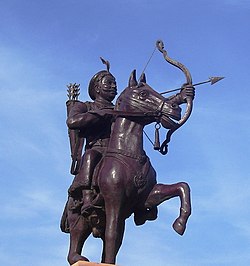- Former Indian cricketer Mahendra Singh Dhoni
- Ranjitsinhji, the Maharaja of Nawanagar, known as the "Father of Indian Cricket"
- Dhyan Chand, widely regarded as the greatest field hockey player in history
Saints

- Mirabai, a princess and celebrated saint of the Bhakti movement and a devotee of Lord Krishna [1]
- Guru Jambheshwar, aka Jambhoji Panwar , the founder of Bishnoi panth which emphasises on protecting plants and animals. [2]
- Baba Ramdev or Ramdeo Pir, a 14th-century Tanwar (Tomar) ruler and Hindu deity of Gujarat and Rajasthan who worked for the upliftment of poor and downtrodden; also worshiped by Muslims. [3]
- Vachharadada, aka Vachhraj Dada Solanki , Hindu deity from Gujarat who died protecting cows. [4]
- Pabuji, a Hindu folk-diety of Rajasthan, India who belonged to the Rathore clan [5]
- Gogaji, also known as Jaharveer Chauhan , an Indian warrior-hero, venerated as a saint and protector specifically against snake bites [6]
- Pipaji, renounced his throne to become a disciple of the saint Ramananda and is revered as one of the fifteen Bhagats whose hymns are included in the Guru Granth Sahib.[ citation needed ]




















